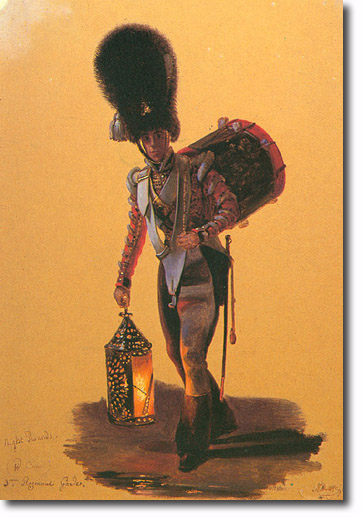|
|

 |
| The artist Dubois Drahonet has exaggerated the height of the bearskin but it is correct in detail as the painting was done from life, using Drummer William Cann as a model. Drahonet was good at lighting his subjects and has produced a painting that is very different from the others in the series. Cann is shown going on night rounds at Lower Westminster. It seems odd that he has to carry his drum whilst performing this duty.
In 1831 the regiment was titled Scots Fusilier Guards and every man issued with a bearskin whereas before, only the grenadier companies wore them. Members of the Corps of Drums had worn a bearskin up until 1800 but after that wore a shako for ordinary duties, retaining the bearskin for ceremonial parades. Now they wore the bearskin for all dress parades and manoeuvres. It was of black fur with a thistle and crown badge at the front, white tassels at the right side and a white plume on the left. The plume was discontinued by around 1835. The brass chin chain looks quite loose on his elongated face. The coat worn by the Corps of Drums in the Scots Guards differed from the other Guards regiments in that the lace chevrons on the sleeves had white tufted fringes on the lower edge. The fringe on the edge of the shoulder wings was enlarged to look like the wings of the privates of line infantry. The lace was white with blue fleur-de-lys designs. It was applied as button loops across the chest, laid in groups of three. On top of the coat, the drummer wore broad white leather belts, a pouch on one and a sword on the other. The sword can be seen on his left hip with a long sword knot. He has a brass belt plate in the middle of the crossed belts, bearing the regimental badge. The belt used as a drum carriage has a large brass buckle and a metal hook to hold the drum. He has a white leather leg protector which, together with the belts, must have involved a good deal of work keeping them well clean with pipe clay. |
Regimental Band | Regimental details
Armed Forces | Art and Culture | Articles | Biographies | Colonies | Discussion | Glossary | Home | Library | Links | Map Room | Sources and Media | Science and Technology | Search | Student Zone | Timelines | TV & Film | Wargames